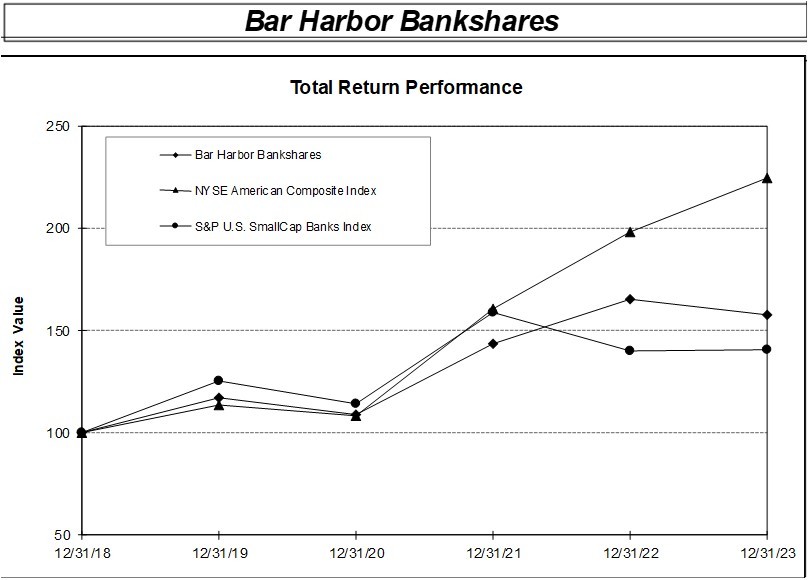cash flows and market-based approaches, indicated that the estimated fair value of our sole reporting unit “Bar Harbor Bank & Trust” exceeded the carrying value. In a future assessment, we could conclude that all or a portion of our goodwill is impaired, which would result in a non-cash charge to earnings.
Revenues from our wealth management business are significant to earnings.
Generating returns that satisfy customers in a variety of asset classes is important to maintaining existing business and attracting new business. Administering or managing assets in accordance with the terms of governing documents and applicable laws is also important to client satisfaction. Failure in either of the foregoing areas can expose us to liability, and result in a decrease in revenues and earnings.
Our wealth management business may be negatively affected by changes in economic and market conditions.
A decline in economic conditions, such as recession, economic downturn, and/or inflationary conditions, changes in domestic and foreign economic conditions, volatility in financial markets, and general trends in business and finance, all of which are beyond our control, could adversely impact the market value of wealth management AUM, which are primarily marketable securities, and the fee revenues derived from the management of these assets.
Strategic and External Risks
Changes and instability in economic conditions, geopolitical matters and financial markets, including a contraction of economic activity, could adversely impact our business, results of operations and financial condition.
Our success depends, to a certain extent, upon global, domestic and local economic and political conditions, as well as governmental monetary policies. Conditions such as changes in interest rates, money supply, levels of employment and other factors beyond our control may have a negative impact on economic activity. Any contraction of economic activity, including an economic recession, may adversely affect our asset quality, deposit levels and loan demand and, therefore, our earnings. In particular, interest rates are highly sensitive to many factors that are beyond our control, including global, domestic and local economic conditions and the policies of various governmental and regulatory agencies and, specifically, the FRB. Throughout 2023 the Federal Open Market Committee (“FOMC”) raised the target range for the Federal funds rate on four separate occasions and-citing factors including the hardships caused by the ongoing Russia-Ukraine conflict, an economic slowdown in China, continued global supply chain disruptions and imbalances, and increased inflationary pressure-the FOMC has indicated that ongoing increases may be appropriate.
The tightening of the FRB's monetary policies, including repeated and aggressive increases in the target range for the Federal funds rate as well as the conclusion of the FRB's tapering of asset purchases, together with ongoing economic and geopolitical instability, increases the risk of an economic recession. Although forecasts have varied, many economists are projecting that U.S. economic growth will slow and inflation will remain elevated in the coming quarters, potentially resulting in a contraction of U.S. gross domestic output in 2024. Any such downturn, especially domestically and in the regions in which we operate, may adversely affect our asset quality, deposit levels, loan demand and results of operations.
As a result of the economic and geopolitical factors discussed above, financial institutions also face heightened credit risk, among other forms of risk. Of note, because we have a significant amount of real estate loans, decreases in real estate values could adversely affect the value of property used as collateral, which, in turn, can adversely affect the value of our loan and investment portfolios. Adverse economic developments, specifically including inflation-related impacts, may have a negative effect on the ability of our borrowers to make timely repayments of their loans or to finance future home purchases. Moreover, while certain commercial real estate values have stabilized as demand has returned to pre-pandemic levels in several markets; the post-pandemic outlook for commercial real estate demand remains dependent on the broader economic environment and, specifically, how major subsectors respond to a rising interest rate environment, the reduction of office utilization due to the impact of hybrid working patterns, greater flexibility for work location, and higher prices for commodities, goods and services. In each case, credit performance over the medium- and long-term is susceptible to economic and market forces and therefore forecasts remain uncertain. Instability and uncertainty in the commercial and residential real estate markets, including headwinds for mortgage rates, lease rates and landlord cash flows, as well as in the broader commercial and retail credit markets, could have a material adverse effect on our financial condition and results of operations.


